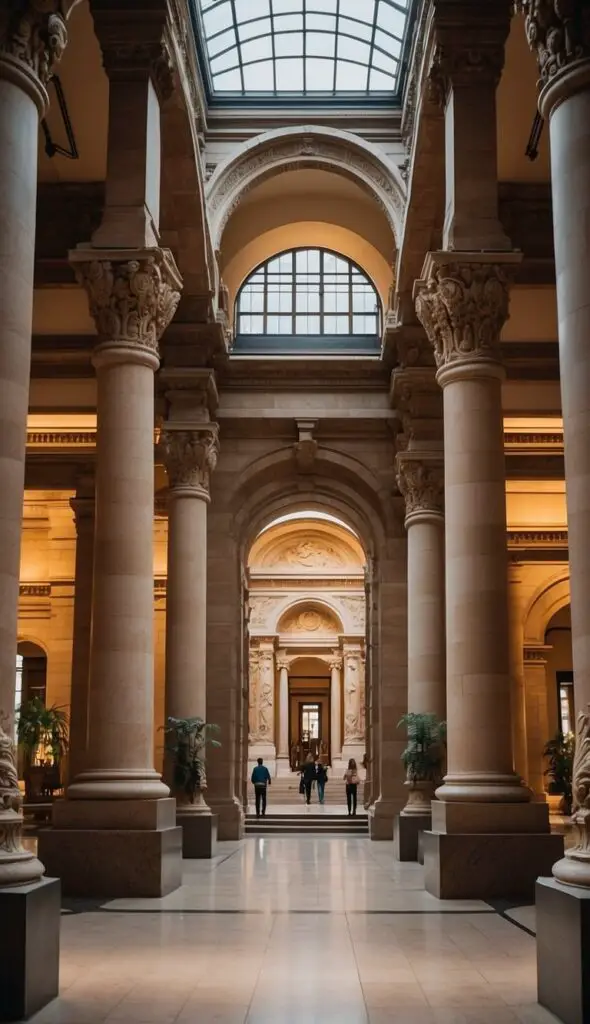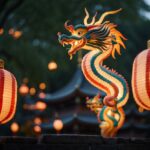Nestled within Philadelphia’s vibrant University City neighborhood, the Penn Museum stands as a beacon of cultural exploration and historical marvel. Located in the University of Pennsylvania’s campus, this renowned institution beckons visitors from around the globe to immerse themselves in the rich tapestry of human history. From the imposing facade of its Greco-Roman architecture to the treasures housed within its galleries, the Penn Museum offers an unparalleled journey through time and across continents.
As visitors step through its doors, they are transported into a world where ancient civilizations come to life. The museum’s vast collections, spanning over a million artifacts, offer a glimpse into the customs, beliefs, and achievements of cultures from every corner of the globe. Whether marveling at the towering Sphinx in the Egypt Gallery or deciphering the intricate hieroglyphs of the Maya, each exhibit serves as a testament to the enduring legacy of humanity’s past.
Adjacent to the Penn Museum lies a trove of additional attractions and green spaces waiting to be explored. Just a stone’s throw away, visitors can stroll through the picturesque campus of the University of Pennsylvania, with its historic buildings and lush greenery providing a serene backdrop for leisurely walks. For those seeking a taste of nature amidst the urban landscape, nearby Clark Park offers a sprawling oasis complete with playgrounds, picnic areas, and a bustling farmer’s market.
Venture a bit further, and you’ll find yourself in the vibrant neighborhood of University City, teeming with eclectic eateries, trendy boutiques, and cultural hotspots. From the historic beauty of the Walnut Street Theatre to the cutting-edge exhibits of the Institute of Contemporary Art, there’s no shortage of attractions to complement your visit to the Penn Museum. So, whether you’re a history buff, an art enthusiast, or simply a curious explorer, a trip to the Penn Museum promises an unforgettable adventure in the heart of Philadelphia’s cultural district.
Table of Contents
Overview
The Penn Museum, situated in the bustling University City neighborhood of Philadelphia, Pennsylvania, stands as a venerable institution dedicated to the exploration and preservation of human history and culture. Since its establishment in 1887, the museum has served as a bastion of archaeological research, housing an extensive collection of artifacts from civilizations spanning the globe and millennia. Its imposing Greco-Roman architecture and sprawling galleries provide the perfect setting for visitors to embark on a journey through time, delving into the mysteries of ancient civilizations and their enduring legacies.
At the heart of the Penn Museum’s allure lies its unparalleled collection of over one million artifacts, carefully curated to showcase the diverse cultures that have shaped humanity’s collective narrative. From the majestic Sphinx in the Egypt Gallery to the intricate pottery of ancient Mesopotamia, each artifact offers a window into the customs, beliefs, and achievements of civilizations long gone. Through immersive exhibitions and engaging displays, visitors are invited to unravel the stories of the past and gain a deeper understanding of the world’s cultural tapestry.
Beyond its role as a repository of artifacts, the Penn Museum serves as a hub for scholarly research and education, fostering collaboration between experts and enthusiasts alike. Through partnerships with universities, archaeological expeditions, and educational programs, the museum continues to push the boundaries of knowledge, shedding new light on the complexities of human history. Whether attending a lecture by a renowned archaeologist, participating in a hands-on workshop, or exploring the museum’s interactive exhibits, visitors of all ages are sure to find inspiration and enlightenment within its walls.
With its prime location in the heart of Philadelphia’s cultural district, the Penn Museum is surrounded by a wealth of attractions and green spaces waiting to be discovered. From the picturesque campus of the University of Pennsylvania to the vibrant energy of nearby University City, there’s no shortage of opportunities for exploration and enrichment. Whether you’re a history enthusiast, an art aficionado, or simply a curious traveler, a visit to the Penn Museum promises an unforgettable experience filled with wonder, discovery, and the timeless allure of human civilization.
The Sphinx Gallery
At the heart of the Penn Museum’s captivating allure lies the Sphinx Gallery, a mesmerizing testament to the grandeur of ancient Egypt. Dominating the space with its imposing presence, the Sphinx stands as the largest of its kind in the Western Hemisphere, captivating visitors with its enigmatic gaze and timeless allure. Crafted over four millennia ago, this colossal statue serves as a symbol of Egypt’s rich cultural heritage and enduring legacy.
As visitors step into the Sphinx Gallery, they are transported back in time to the banks of the Nile, where pharaohs ruled and monumental structures rose in tribute to the gods. Surrounding the Sphinx are a wealth of artifacts and treasures from ancient Egypt, each offering insights into the daily life, religious beliefs, and artistic achievements of this remarkable civilization. From intricately carved hieroglyphs to exquisite funerary objects, the gallery’s displays provide a comprehensive overview of Egypt’s illustrious past.
One of the highlights of the Sphinx Gallery is the monumental granite Sphinx itself, which stands at an impressive 25 feet tall and weighs over 12 tons. Carved in the likeness of the pharaoh Amenhotep II, the Sphinx is a masterpiece of ancient Egyptian artistry, featuring intricate details and a serene expression that has captivated audiences for centuries. Surrounding the Sphinx are additional artifacts, including fragments from the great temples of Karnak and Luxor, offering a glimpse into the architectural marvels of ancient Egypt.
Beyond its role as a showcase for ancient artifacts, the Sphinx Gallery serves as a hub for education and exploration, inviting visitors to delve deeper into the mysteries of ancient Egypt. Through interactive exhibits, guided tours, and educational programs, visitors of all ages are invited to uncover the secrets of the Sphinx and explore the fascinating world of ancient Egyptian civilization. Whether marveling at the sheer scale of the statue or deciphering the hieroglyphs adorning its surface, a visit to the Sphinx Gallery is sure to leave a lasting impression on all who enter its hallowed halls.
The Artifact Collections
At the Penn Museum, the Artifact Collections stand as a testament to the rich tapestry of human history, offering visitors a glimpse into the diverse cultures and civilizations that have shaped our world. Spanning continents and millennia, the museum’s extensive collections house over a million artifacts, each telling a unique story of the people who created them.
From the ancient civilizations of Mesopotamia and Egypt to the indigenous cultures of the Americas and beyond, the Artifact Collections showcase the ingenuity, creativity, and resilience of humanity throughout the ages. Visitors can explore a wide range of artifacts, including pottery, jewelry, tools, weapons, and religious objects, each offering insights into the customs, beliefs, and daily lives of past societies.
One of the highlights of the Artifact Collections is the museum’s renowned collection of Egyptian artifacts, which includes mummies, sarcophagi, and hieroglyphic inscriptions dating back thousands of years. Visitors can marvel at the intricate craftsmanship of these ancient artifacts and gain a deeper understanding of the religious beliefs and funerary practices of the ancient Egyptians.
In addition to its Egyptian collection, the museum boasts an impressive array of artifacts from ancient Mesopotamia, including cuneiform tablets, cylinder seals, and monumental sculptures. These artifacts provide valuable insights into the development of writing, law, religion, and government in one of the world’s earliest civilizations.
Beyond the ancient world, the Artifact Collections also include artifacts from cultures across Africa, Asia, the Americas, and Oceania, showcasing the diversity of human cultures and traditions. From the intricately carved masks of West Africa to the exquisite textiles of the Andes, each artifact offers a window into the rich cultural heritage of its creators.
Through its Artifact Collections, the Penn Museum invites visitors on a journey of discovery, encouraging them to explore the wonders of human creativity, ingenuity, and resilience. Whether marveling at the monumental sculptures of ancient Mesopotamia or admiring the delicate craftsmanship of indigenous textiles, a visit to the Artifact Collections is sure to inspire awe and wonder in visitors of all ages.
The Worlds Intertwined Gallery
At the Penn Museum, the Worlds Intertwined Gallery serves as a captivating exploration of the interconnectedness of human cultures across time and space. Through innovative exhibits and interactive displays, visitors are invited to embark on a journey through the complex web of relationships that have shaped our world.
As visitors enter the Worlds Intertwined Gallery, they are greeted by a dynamic and immersive experience that highlights the themes of migration, trade, and cultural exchange. From ancient trade routes to modern migration patterns, the gallery illuminates the ways in which human societies have interacted and influenced one another throughout history.
One of the key highlights of the Worlds Intertwined Gallery is its focus on the Silk Road, the ancient network of trade routes that connected the East and West. Through artifacts, maps, and multimedia presentations, visitors can trace the journey of silk, spices, and other goods along this historic route, gaining insights into the cultural exchanges and innovations that flourished along its path.
In addition to the Silk Road, the gallery explores other important channels of cultural exchange, including maritime trade routes, pilgrimage routes, and migration corridors. Visitors can learn about the movement of people, ideas, and technologies across continents and oceans, and the profound impact that these exchanges have had on the development of human civilization.
Through its thought-provoking exhibits and engaging storytelling, the Worlds Intertwined Gallery challenges visitors to rethink their understanding of history and culture, emphasizing the interconnectedness and interdependence of all human societies. Whether exploring the spread of religions, the exchange of artistic styles, or the transmission of scientific knowledge, visitors are invited to discover the rich tapestry of connections that unite us all.
The Native American Voices Gallery
At the Penn Museum, the Native American Voices Gallery stands as a testament to the rich and diverse cultures of indigenous peoples across North and South America. Nestled within the museum’s hallowed halls, this immersive exhibition invites visitors to embark on a journey through time, exploring the vibrant heritage and enduring traditions of Native American communities.
As visitors step into the Native American Voices Gallery, they are greeted by a breathtaking array of artifacts, artwork, and interactive exhibits that showcase the resilience, creativity, and spirituality of indigenous peoples. From ancient pottery and ceremonial objects to contemporary artwork and oral histories, the gallery offers a comprehensive overview of Native American life and culture.
One of the key highlights of the gallery is its focus on the ongoing legacy of Native American peoples, highlighting the ways in which traditional practices and cultural traditions continue to thrive in the modern world. Through multimedia presentations and firsthand accounts from indigenous voices, visitors gain a deeper understanding of the challenges and triumphs faced by Native American communities today.
In addition to its emphasis on contemporary issues, the gallery also delves into the rich history of Native American peoples, exploring topics such as colonization, resistance, and cultural revitalization. Visitors can learn about the diversity of indigenous languages, the significance of sacred sites, and the importance of storytelling in preserving cultural heritage.
Through its thought-provoking exhibits and engaging storytelling, the Native American Voices Gallery offers visitors a glimpse into the past, present, and future of Native American communities. Whether exploring the intricacies of tribal governance, the beauty of indigenous art forms, or the spiritual significance of traditional ceremonies, visitors are invited to celebrate the resilience and vitality of Native American cultures.
The Asian Collections
At the Penn Museum, the Asian Collections offer a captivating glimpse into the rich and diverse cultures of Asia, spanning millennia of history and encompassing a vast array of artistic and cultural treasures. Nestled within the museum’s expansive galleries, these collections invite visitors on a journey through the storied civilizations of China, Japan, India, and beyond.
As visitors step into the Asian Collections, they are transported into a world of unparalleled beauty and sophistication, where ancient traditions and modern innovations converge in a vibrant tapestry of cultural expression. From exquisite ceramics and intricate textiles to monumental sculptures and religious artifacts, the collections offer a comprehensive overview of the region’s artistic and cultural heritage.
One of the highlights of the Asian Collections is its focus on the ancient civilizations of China, whose rich history and artistic achievements have captivated audiences for centuries. Visitors can marvel at the delicate beauty of Ming Dynasty porcelain, explore the intricacies of traditional Chinese calligraphy, and gain insights into the spiritual beliefs and philosophical traditions that have shaped Chinese culture.
In addition to its emphasis on China, the Asian Collections also feature a wealth of artifacts from other key regions of Asia, including Japan, India, Southeast Asia, and the Himalayan kingdoms. Visitors can immerse themselves in the serene beauty of Japanese Zen gardens, discover the intricate symbolism of Indian temple carvings, and explore the rich cultural heritage of the Mughal Empire.
Through its thought-provoking exhibits and engaging storytelling, the Asian Collections offer visitors a deeper understanding of the diverse cultures and civilizations that have flourished across Asia. Whether exploring the timeless elegance of Japanese tea ceremonies, the vibrant colors of Indian textiles, or the spiritual significance of Buddhist art, visitors are invited to celebrate the richness and complexity of Asia’s cultural heritage.
The Africa Galleries
At the Penn Museum, the Africa Galleries stand as a vibrant tribute to the continent’s rich and diverse cultures, spanning thousands of years of history and encompassing a vast array of artistic, religious, and social traditions. Nestled within the museum’s expansive halls, these galleries offer visitors an immersive journey through the many facets of African life, from ancient kingdoms to contemporary societies.
As visitors step into the Africa Galleries, they are greeted by a breathtaking array of artifacts, artwork, and interactive exhibits that showcase the ingenuity, creativity, and resilience of African peoples. From intricately carved masks and ceremonial regalia to exquisite textiles and religious objects, the galleries offer a comprehensive overview of the continent’s artistic and cultural heritage.
One of the highlights of the Africa Galleries is its focus on the ancient civilizations of Egypt, whose monumental achievements continue to captivate audiences around the world. Visitors can marvel at the towering statues of pharaohs, explore the intricacies of hieroglyphic writing, and gain insights into the religious beliefs and burial practices of ancient Egypt.
In addition to its emphasis on Egypt, the Africa Galleries also feature a wealth of artifacts from other regions of the continent, including West Africa, Central Africa, East Africa, and Southern Africa. Visitors can immerse themselves in the vibrant traditions of West African masquerade festivals, discover the rich symbolism of Central African sculptures, and explore the intricate beadwork of Maasai warriors.
Through its thought-provoking exhibits and engaging storytelling, the Africa Galleries offer visitors a deeper understanding of the diverse cultures and civilizations that have flourished across Africa. Whether exploring the rhythmic beats of African music, the intricate patterns of African textiles, or the spiritual significance of African masks, visitors are invited to celebrate the richness and complexity of Africa’s cultural heritage.
The Mexico and Central America Gallery
At the Penn Museum, the Mexico and Central America Gallery serves as a captivating window into the ancient civilizations that once flourished in this region, from the enigmatic Maya to the powerful Aztec and beyond. Nestled within the museum’s expansive halls, this gallery offers visitors an immersive journey through the rich cultural heritage and monumental achievements of Mesoamerican peoples.
As visitors step into the Mexico and Central America Gallery, they are transported back in time to a world of towering pyramids, intricate artwork, and sophisticated civilizations. From the imposing ruins of Teotihuacan to the intricate carvings of Palenque, the gallery showcases the architectural marvels and artistic achievements of ancient Mesoamerica.
One of the highlights of the gallery is its focus on the Maya civilization, whose enigmatic cities and intricate calendar systems continue to fascinate scholars and visitors alike. Visitors can marvel at the intricate hieroglyphs of Maya stelae, explore the majestic temples of Tikal, and gain insights into the spiritual beliefs and rituals of this ancient civilization.
In addition to its emphasis on the Maya, the Mexico and Central America Gallery also features artifacts from other key cultures of the region, including the Aztec, Olmec, Zapotec, and Mixtec. Visitors can immerse themselves in the vibrant colors of Aztec codices, discover the mysterious stone heads of the Olmec, and explore the intricate goldwork of the Mixtec.
Through its thought-provoking exhibits and engaging storytelling, the Mexico and Central America Gallery offers visitors a deeper understanding of the complex societies and cultures that once thrived in this region. Whether marveling at the monumental architecture of Mesoamerican cities, deciphering the symbolism of ancient artifacts, or exploring the daily lives of ancient peoples, visitors are invited to celebrate the rich and diverse heritage of Mexico and Central America.
The Museum’s Role in Research and Education
The Penn Museum’s role in research and education extends far beyond its role as a repository of artifacts; it serves as a dynamic hub for scholarly inquiry, collaborative research, and educational outreach. Since its establishment, the museum has been at the forefront of archaeological and anthropological research, contributing to our understanding of the past while inspiring future generations of scholars and enthusiasts.
At the heart of the museum’s mission is its commitment to advancing knowledge through interdisciplinary research. Through partnerships with universities, research institutions, and archaeological expeditions around the world, the museum facilitates groundbreaking research projects that uncover new insights into human history, culture, and society. From excavations in Egypt and Mesopotamia to fieldwork in the Americas and beyond, the museum’s research initiatives span continents and millennia, shedding light on the complexities of the human experience.
In addition to its role in research, the Penn Museum is dedicated to sharing its discoveries and insights with the public through a wide range of educational programs and outreach initiatives. From lectures and symposiums to workshops and field trips, the museum offers a diverse array of opportunities for visitors of all ages to engage with the fascinating world of archaeology and anthropology. Through interactive exhibits, hands-on activities, and multimedia presentations, visitors are invited to explore the museum’s collections and learn about the cultures and civilizations that have shaped our world.
Moreover, the museum’s commitment to education extends beyond its physical walls through digital resources, online courses, and virtual exhibits that reach audiences around the globe. By harnessing the power of technology and innovation, the museum is able to share its wealth of knowledge and expertise with a diverse and global audience, inspiring curiosity, fostering understanding, and promoting cultural appreciation.
In summary, the Penn Museum’s role in research and education is not only integral to its mission but also to its legacy as a leading institution in the field of archaeology and anthropology. Through its dedication to scholarship, collaboration, and outreach, the museum continues to inspire curiosity, advance knowledge, and promote cross-cultural understanding in an ever-changing world.
Special Exhibitions and Events
Special exhibitions and events at the Penn Museum offer visitors unique opportunities to delve deeper into specific topics, explore the latest archaeological discoveries, and engage with leading scholars and experts in the field. These temporary exhibitions showcase the museum’s diverse collections and highlight emerging themes and research areas in archaeology, anthropology, and museum studies. Whether featuring artifacts from a specific region or time period, exploring interdisciplinary themes, or presenting cutting-edge research, these exhibitions offer visitors fresh perspectives on the richness and complexity of human cultures.
Some of the notable special exhibitions and events at the Penn Museum include:
- “Echoes of the Past: Ancient Technologies and Modern Innovation”: This exhibition explores the fascinating parallels between ancient technologies and modern innovations, showcasing how ancient peoples developed ingenious solutions to the challenges of their time. Through interactive exhibits, visitors can learn about ancient methods of agriculture, engineering, and craftsmanship, and discover how these innovations continue to inspire and inform modern technology.
- “Lost Cities of the Ancient World”: Delve into the mysteries of lost civilizations with this captivating exhibition, which explores the stories of ancient cities that have been buried beneath the sands of time. From Pompeii to Petra, visitors can learn about the rise and fall of these once-great cities, uncovering the secrets of their architecture, culture, and demise through artifacts, reconstructions, and multimedia presentations.
- “Cultural Crossroads: Exploring the Diversity of Human Experience”: This interdisciplinary exhibition celebrates the diversity of human cultures and the interconnectedness of global civilizations. Through artifacts, artworks, and interactive displays, visitors can explore themes of migration, trade, and cultural exchange, gaining insights into the shared experiences and unique identities of peoples around the world.
- “Voices from the Field: Archaeological Discoveries in Progress”: Get a behind-the-scenes look at the latest archaeological discoveries and ongoing research projects with this special exhibition, which highlights the work of field archaeologists and scholars from around the world. Through photographs, videos, and firsthand accounts, visitors can learn about the excitement and challenges of archaeological fieldwork, and gain a deeper understanding of the process of discovery.
These special exhibitions and events offer visitors of all ages the opportunity to engage with the museum’s collections, learn from leading experts in the field, and explore the rich diversity of human cultures past and present. Whether attending a lecture by a renowned archaeologist, participating in a hands-on workshop, or simply exploring the galleries, visitors are sure to find inspiration and enlightenment at the Penn Museum.
Conclusion
In conclusion, the Penn Museum stands as a beacon of knowledge, curiosity, and cultural appreciation in the heart of Philadelphia’s vibrant University City neighborhood. Through its extensive collections, groundbreaking research, and engaging exhibitions and events, the museum offers visitors a unique opportunity to explore the richness and diversity of human cultures across time and space. From the towering statues of ancient Egypt to the intricate textiles of indigenous peoples, each artifact tells a story of the people who created it, illuminating the complexities of the human experience and fostering a deeper appreciation for the interconnectedness of global civilizations.
As a center for research, education, and community engagement, the Penn Museum continues to inspire curiosity, spark dialogue, and promote cross-cultural understanding in an ever-changing world. Whether attending a lecture by a renowned scholar, participating in a hands-on workshop, or simply exploring the galleries, visitors are invited to embark on a journey of discovery, enlightenment, and wonder. With its unwavering commitment to scholarship, collaboration, and outreach, the Penn Museum remains a vital institution, dedicated to preserving the past, informing the present, and inspiring future generations for years to come.





